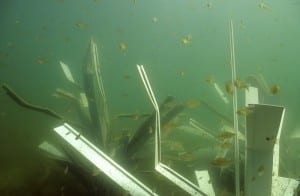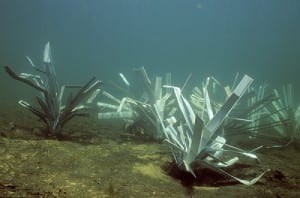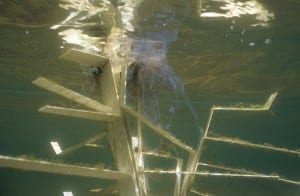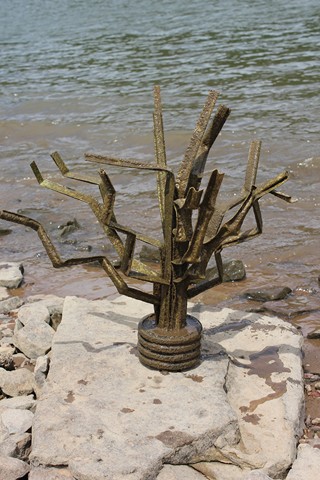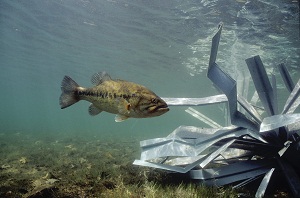|
Tag: fish spawning
GreenView: Sierra Club applauds the new Great Lakes Water Quality Agreement
Updated GLWQA signed in Washington DC, September 7, 2012
By Mary Muter, Chair Sierra Club Canada Great Lakes Section
After 25 years the governments of Canada and the United States have finally come together on the terms of a new revised Great Lakes Water Quality Agreement (online here) that better reflects the current conditions of the Great Lakes than the 1987 Agreement. This new Agreement has three new Annexes – Aquatic Invasive Species, Habitat and Species and Climate Change Impacts – that will be able to take advantage of the increased knowledge on these important issues. The question is: will there be funding and resources to address the new challenges facing the Great Lakes when existing Areas Of Concern like Toronto and Detroit continue to show little sign of improvement? Dozens of unique habitat models at fishiding.com
Sierra Club applauds the governments’ commitment to prevent further loss of habitat and species that contribute to the protection of Great Lakes water quality. Those high quality coastal wetlands still intact on the Great Lakes would have to be at the top of the list needing protection. We have already lost 70% of coastal wetlands on Lakes Ontario and Erie due to pollution and/or development. Great Lakes wetlands are needed by about 80% of Great Lakes fish for spawning and or nursery habitat. If Great Lakes fish cannot find suitable spawning habitat they simply do not spawn. The Ontario Ministry of Natural Resources has already identified declining Northern Pike and Musky populations due to 13 years of sustained low water levels and loss of wetland habitat on Lakes Huron and Georgian Bay. We will be watching to see if the development and implementation of lakewide habitat and species protection, restoration, and conservation strategies will be met in their two year stated objective. Another critical issue will be whether individual targets or goals can be established for each Great Lake that reflect background conditions.
Will there be enough resources to meet these lofty objectives? It is hard to believe these objectives can be met while the Government of Canada has eliminated hundreds of science positions including closing the Experimental Lakes Project – the research station where Dr. David Schindler’s internationally respected ground-breaking research to identify phosphorus as the leading cause of algal growth. Where would we be today without that critical knowledge?
We need strengthened legislation not the weakened sections of the Fisheries Act by the removal of fish habitat. This one action alone has left thousands of un-assessed coastal wetlands now vulnerable to encroachment or degradation due to development.
Sierra Club hopes the new Agreement will better protect and restore the Great Lakes. To accomplish that our governments in Canada and the United States will need to involve the public at a very high level to ensure accountability and progress. We have a very valuable bi-national resource in the Great Lakes; to protect and restore them we require the best possible public and government actions along with the required resources. Only then will the obligations under this Agreement be fulfilled.
Last chance to secure funds for fish habitat
Time is running out to apply for more than half a million dollars worth of grants for projects to enhance recreational fishing throughout NSW. Dozens of unique habitat models at fishiding.com
Department of Primary Industries (DPI) Conservation Manager, David Cordina, said applications for the NSW Government’s Habitat Action Grant program close at 5pm on Friday 28 September 2012.
“Habitat Action Grant program grants of up to $40,000 are available for individuals or groups interested in rehabilitating fish habitat,” he said.
“These grants are open to fishing clubs, Landcare, Rivercare and other community groups, individuals, local councils and Catchment Management Authorities wanting to improve habitat for recreational fish in their local area.
“This program supports local communities in protecting good habitat, and rehabilitating degraded habitat for more productive recreational fisheries.”
Mr Cordina said projects that will be considered include bank stabilisation works, removal of barriers to fish passage, rehabilitation of riparian lands, re-snagging waterways, weed control works and reinstatement of natural flow regimes.
“Applications must relate to the improvement of fish habitat that provides direct benefit to recreational fishing,” Mr Cordina said.
“Projects that involve recreational fishers will be given preference.
“Previous community projects have provided fantastic outcomes for our native fish and are great examples of how recreational fishing fees are helping to support recreational fishing and boosting fish numbers, naturally.”
“So hurry, you have only weeks left to apply.”
The Habitat Action Grant program is funded from the NSW Recreational Fishing Trusts and is administered by DPI.
For more information about the program, examples of past Habitat Action Grant projects and application forms visit the DPI Habitat Action Grants web page, or call (02) 6881 1277 or (02) 4916 3817.
Media contact: Tom Braz 02 6391 3686 or 0428 256 596
National Fish Habitat Partnership Releases Updated Action Plan to Conserve America’s Aquatic Resources
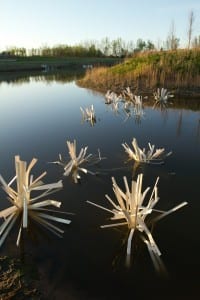
The new, second edition of the National Fish Habitat Action Plan advances science-based conservation mission and incorporates new objectives focused on locally driven efforts to reverse deteriorating fish habitats.

National Fish Habitat Action Plan, Second Edition
Washington, DC (PRWEB) August 29, 2012
The National Fish Habitat Board today released the second edition of the National Fish Habitat Action Plan (Action Plan), setting forth a mission-critical approach to conserving the nation’s aquatic resources for the future. The original National Fish Habitat Action Plan, created in 2006, carried a great vision forward to protect, restore and enhance aquatic habitats through partnerships. While the original Plan met its objectives set forth in 2010, the mission and goals of the plan remain the same and are the foundation of the second edition of the Plan for 2012 and beyond.
The second edition of the National Fish Habitat Action Plan is built on the foundation of advancing the conservation practices of the individual National Fish Habitat Partnerships, the working units of the National Fish Habitat Partnership. The five new objectives in the Plan include:
- Achieve measurable habitat conservation results through strategic actions of Fish Habitat Partnerships that improve ecological condition, restore natural processes, or prevent the decline of intact and healthy systems leading to better fish habitat conditions and increased fishing opportunities.
- Establish a consensus set of national conservation strategies as a framework to guide future actions and investment by the Fish Habitat Partnerships by 2013.
- Broaden the community of support for fish habitat conservation by increasing fishing opportunities, fostering the participation of local communities – especially young people – in conservation activities, and raising public awareness of the role healthy fish habitats play in the quality of life and economic well-being of local communities.
- Fill gaps in the National Fish Habitat Assessment and its associated database to empower strategic conservation action supported by broadly available scientific information, and integrate socio-economic data in the analysis to improve people’s lives in a manner consistent with fish habitat conservation goals.
- Communicate the conservation outcomes produced collectively by Fish Habitat Partnerships as well as new opportunities and voluntary approaches for conserving fish habitat to the public and conservation partners.
The second edition of the Action Plan details how the new objectives will be implemented. The Plan also highlights conservation “Partnership in Action” stories from Fish Habitat Partnerships to provide insight into their work on the ground. Other sections explain the functions of the National Fish Habitat Board and Partnerships and the critical role of science and data and effective communications to guide activities. Interesting facts and figures related to the National Fish Habitat Partnership, recreational and commercial fishing fill out the rest of the Plan. See the dozens of unique habitat models at fishiding.com
“The revised Action Plan is built on the success and experiences of our Partners,” said Kelly Hepler, Chairman of the National Fish Habitat Board and Assistant Commissioner, Alaska Department of Fish and Game. “Creating and maintaining these Partnerships is the foundation of the Action Plan and will be the primary focus as we address conservation needs for our nation’s waterways now and into the future.”
The National Fish Habitat Board, Fish Habitat Partnerships, federal and state natural resource agencies, conservation organizations and the National Fish Habitat Partner Coalition participated in the selection process of the revised Plan objectives. The release of the revised Action Plan coincides with the launch of the updated National Fish Habitat Partnership website at http://www.fishhabitat.org.
To view and download a PDF of the revised Action Plan, visit http://www.fishhabitat.org/images/nfhp_ap_final.pdf.
About the National Fish Habitat Partnership
The National Fish Habitat Partnership (http://www.fishhabitat.org) works to conserve fish habitat nationwide—leveraging federal, state and private funding sources to achieve the greatest impact on fish populations through priority conservation projects. The national partnership implements the National Fish Habitat Action Plan and supports 18 regional grassroots partner organizations.
Pond farming takes lead in fish supply
Fish from ponds and ditch now accounts for 41 percent of total yearly production of 30.61 lakh tonnes.
A decade ago, its contribution was 34 percent, according to the Department of Fisheries (DoF).
Contribution of fish caught from rivers fell to 34 percent in fiscal 2010-11.
Declining fish habitat, the ongoing destruction of juvenile fish by using monofilament synthetic nylon fibre net and mosquito net, and environmental pollution are the major reasons behind the falling supplies of fish from rivers.
“An increased production and availability of fingerlings and hatchlings because of growth in hatcheries has played a key role in expansion of fish farming,” said Krishnendu Saha, chief fisheries extension officer of the DoF.
Over the past two decades, private investors established more than 800 fish hatcheries.
Their interest grew due to a business prospect against the backdrop of falling catches in open water areas and rising demand for fish.
Initiatives by the government and NGOs to motivate farmers also facilitated farming for common carp, pangus, monosex tilapia and shing (cat fish) in regions such as Mymensingh, northern districts, Jessore and Comilla.
Saha said many people in these areas entered freshwater fish farming because common carps (ruhi, katla, silver carp), pangus and tilapia become marketable in a short time.
It enables the farmers to gain higher profit from fish than growing crops such as paddy and jute, he said.
“Many people in greater Mymensingh have started fish culturing by making ditches in crop fields,” said Saha.
According to the DoF data, total pond area under fish farming was 2.42 lakh hectares early this decade, and such areas rose to 3.96 lakh hectares in fiscal 2010-11.
Production also rose to 12.70 lakh tonnes in 2010-11 from 11.40 lakh tonnes a year ago.
In fiscal 1999-2000, total production of fish from pond was 5.61 lakh tonnes, according to the DoF.
Sajjad Hossain, managing director of Joyda Aquafarm Ltd, said many people are engaged in pangus farming because it needs low investment.
Technologies were also easy for the farmers to follow, said Hossain of Joyda, which produces pangus fries at hatcheries, cultures those and sells to market.
The company produces 2,500 tonnes of pangus a year, he said.
M Mahfujul Haque, a professor of the Department of Aquaculture of Bangladesh Agricultural University, said the country has a huge potential to expand fish farming as only 11 percent of its pond resources have so far been exploited for fish.
In the past, fish was cultured in ponds by collecting hatchlings from natural sources. But the main breakthrough came since the beginning of artificial propagation, he said.
“Large investments have come in fish farming and some farms have gone for vertical integration,” said Haque
He said expansion of fish farming created job opportunities for many and augmented incomes of farmers. Some 25 types of jobs have been created because of fish farming, he added.
“The socio-economic impact of fish farming is huge,” said Haque, adding that many educated people entered such a farming failing to get jobs in the formal sector.
However, challenges are increasing. See the dozens of unique artificial fish habitat models at fishiding.com, the leader in true fish protection.
“Fries are not growing fast nowadays like the past. Inbreeding is also widespread,” said Hossain of Joyda Aquafarm.
At the same time, productivity of ponds is declining because of continuous farming in the same ponds.
“But production costs are rising because of soaring feed prices and other costs. It reduces profit margins,” he said.Sohel Parvez
Michigan fish habitat reconstruction a great success for the fish
Bringing Back the Fish: Michigan Sea Grant Oversees Successful Habitat Reconstruction |
| By Stephanie Ariganello, Michigan Sea Grant The unmanned camera bounced along a rock reef on floor of the St. Clair River. Researchers watched the monitor. Then a long, dark shape came into focus and another and another. The looming figures were lake sturgeon. The team whooped at the discovery: the restoration was working and much sooner than anticipated. The goals of the project are to:
“It is science in action,” said Jennifer Read, assistant director of Michigan Sea Grant and project lead on the St. Clair River Middle Channel Restoration project. “This is the kind of research project where we’re performing research not just to learn new things, but to apply what we’ve discovered. And with this project, we’ve been rewarded with early success.” The lake sturgeon were congregating on rock reefs installed as part of the restoration project in the St. Clair River, led by Michigan Sea Grant. The project focuses on restoring fish spawning habitat in order to add young fish to the stocks of several endangered or threatened fish species in Michigan, including lake sturgeon, mooneye, northern madtom catfish and river redhorse suckers. Valuable commercial and sport fish such as walleye, lake whitefish and perch are also expected to use the reefs for spawning. “Obviously there was a need for more spawning habitat based on the immediate response by the sturgeon,” said Terry Heatlie, habitat restoration specialist with NOAA Fisheries Restoration Center, Great Lakes Regional office. “It’s special because this would not have happened without the restoration project, without restoring spawning habitat in the river.” click to expand image  Reef habitat restoration in the St. Clair River Middle Channel. Credit: Michigan Sea Grant Reef habitat restoration in the St. Clair River Middle Channel. Credit: Michigan Sea GrantWhen given enough time, Heatlie said, some land or water issues heal themselves. With habitat restoration, that is not typically the case. It requires intervention. The construction was completed in June. Nine rock reefs were created, providing an acre of restored fish spawning habitat in the river. The St. Clair River connects the waters of Lake Huron to Lake St. Clair, where water then flows through the Detroit River and eventually into Lake Erie. The channel is a major shipping route and forms a border between the U.S. and Canada. Because of its location in the heart of the Great Lakes, the restoration has potential to benefit waters upstream and downstream of the construction. The restoration efforts could also provide cultural and economic benefits, bolstering commercial and sport fishing and contributing to a higher quality of life in an area currently listed as an Area of Concern under the U.S.-Canada Great Lakes Water Quality Agreement. See the dozens of unique artificial fish habitat models, fish attractors and fish cover at fishiding.com, the leader in proven science based, fish protection. In the early 1900s, the rivers connecting Lakes Huron and Erie were widened and deepened to accommodate larger, modern commercial shipping vessels. Dredging and depositing the materials in different locations in the river damaged fish spawning sites — and subsequently, fish populations. click to expand image  Researchers inspect egg mats as part of the Middle Channel Restoration project. Credit: Michigan Sea Grant Researchers inspect egg mats as part of the Middle Channel Restoration project. Credit: Michigan Sea GrantTo compensate for the habitat loss, Michigan Sea Grant and project partners (U.S. Geological Survey, Michigan Department of Natural Resources, U.S. Fish & Wildlife Service, the University of Michigan, NOAA, SmithGroup JJR andMichigan Wildlife Conservancy) constructed two reef projects previously in the Detroit River. The location and design of the Middle Channel reefs were chosen based on studies of fish populations and lessons learned during the previous projects. “That’s what is really unique about the Middle Channel project,” said Read. “It reflects over ten years of work performed by a multi-agency science team tackling increasingly complex questions over a large geographical area. It represents a successful, system-wide approach to restoration.” Researchers surveyed the new reefs and collected eggs. It was confirmed. Lake sturgeon successfully deposited and fertilized their eggs on the reefs and the eggs produced viable sturgeon larvae. Post-construction assessments are planned to ensure the Middle Channel Reefs are being used by a variety of fish species. The goal, aside from reestablishing the habitat, is to help remove the St. Clair River from the bi-national list of Areas of Concern. Two more spawning reefs for native fish are being planned for the St. Clair River in 2013 and 2014, as part of the Great Lakes Restoration Initiative. |
Texas tree top habitat causes Govenor intervention.
Dear friends,
I was recently contacted by J Harmon, President of the Protect lake Dunlap association in New Braunfels,Texas. He explained to me their struggle with the Guadalupe-Blanco River Authority over existing small diameter standing timber being hazardous to recreation use. Apparently, The GBRA has denied the cutting of these stumps to protect fish habitat and recommends marking these areas off to boat use which has the residents upset.
See the dozens of unique artificial fish habitat models, fish attractors and fish cover at fishiding.com, the leader in proven science based, fish protection.
The PLDA’s plan is to draw down the reservoir and shorten the existing hazards about eight feet from normal surface elevation. I’m told there are hundreds of them and already have caused many accidents and property damage. J says the average depth is about 15 feet, so when cut, they would still stick up about 6-8 feet off the bottom, root ball intact.
After cutting, they plan to set one of our PVC habitat units on the remaining stump and fasten it there for good. This would increase the square footage of surface area approximately three times. The thinking is, with our units within six feet of the surface as water fluctuates, boats, skiers and water craft will be safe, including the fish. J and the group understand the benefits of not only keeping as much existing habitat as possible but to continue to add more habitat. The cut off tops would be kept and fastened to the remaining trunk too.
They have a full understanding of the science behind periphyton, nutrient removal and fish production and feel unwavering in their decision to work with only us in their efforts.
Senator Jeff Wentworth supports PLDA. With his intervention and the phone call from Gov. Rick Perry, GBRA’s action item #8 was tabled. The PLDA has been granted 30 days, (less now) to present their case for a final decision of what will be allowed. The General Manager and staff continue to meet with representatives of Lake Dunlap, enforcement officers, and fishery experts to evaluate the current no-wake area designation and alternative options to provide water safety and assure a balance of all uses including the preservation of fishery habitat and funding mechanisms, and to continue to review and develop alternatives that address congestion and lake boating conflict uses on Lake Dunlap and to report back to the Board at its next regularly scheduled meeting in August 2012.
What I’m asking of you once again is your opinion, hopefully your support. Can you find any adverse effects of removing these hazardous stumps as long as the habitat is replaced in other ways/forms? Can you comment on the benefits of the artificial habitat we produce and results you have seen? What can we expect to see in a 300 % increase in available cover for the fishery? With our help, the PLDA intends to present their plan for approval as a landmark decision for the state of Texas. Safety for the residents and fish is the priority of both sides, in that order. All parties involved want to save and increase fish habitat. Wood is good, just not where people get hurt. Send replies to either Jarod or myself at david@fishiding.com Thanks.
Here are some links to the information as well as Jerod Harmon’s contact information:
news story:
http://www.ksat.com/news/Lake-Dunlap-res…rz/-/index.htmlhttp://www.plda.org/index.htmlhttps://docs.google.com/viewer?url=http%3A%2F%2Fwww.plda.org%2Ffiles%2Fstump_removal_procedure.pdfhttp://www.gbra.org/
jrharmon123@yahoo.com
713-202-8870
Pro’s opinion after one year…Artificial fish habitat rocks!
See what professional fishing guide, photographer and accomplished writer Brad Wiegmann, has to say about fishiding habitat products.
Adding Artificial PVC Fish Attractors with Fishiding
See the dozens of unique artificial fish habitat models, fish attractors and fish cover used at fishiding.com, the leader in proven science based, fish protection.
Fishiding underwater photos by Engbretson Underwater photography
http://underwaterfishphotos.blogspot.com/2012/06/artificial-fish-habitat.html
See the dozens of unique artificial fish habitat models, fish attractors and fish cover used at fishiding.com, the leader in proven science based, fish protection.
DNR Aquatic Habitat Program provides cost share for habitat restoration
See the dozens of unique artificial fish habitat models, fish attractors and fish cover used at fishiding.com, the leader in proven science based, fish protection.
Conservation groups, lake associations and local governments can help improve fish habitat and water quality through a Minnesota Department of Natural Resources (DNR) grants program. Read more…………fish


